Life after the Kigamboni bridge

A boda boda rider waits for customers at the bridge, which was inaugurated in April by President Magufuli who named it after the father of the nation, Mwalimu Nyerere.
PHOTOSI ANNE KIDMOSE JENSEN.
What you need to know:
The bridge connects the CBD with Kigamboni ward. To some it eases movements, while to others it disconnects their means of living
The Nyerere Bridge, from Kurasini in Dar es Salaam over the creek to Kigamboni ward rises like a grey giant with his two legs planted on each sides of the water.
Approaching the bridge from the heavy traffic on Mandela Road feels like entering a different realm of wide and spacious roads, and the many cables from the two pylons shine down on the by-passer who walks like an ant figure far beneath them. Only a few cars take up the space on the tarmac, but the pedestrian walks on each side of the tarmac are busy with commuters.
Manzi Juma walks shielded by the railings and to his right is the dark blue water. On the Kigamboni shore a group of wooden boats are left alone on the sand. Since the bridge was opened on the 16th of April, 39-year-old Manzi has crossed it by foot on mornings and evenings to and from his work as a truck driver on the harbour of Dar es Salaam. He crosses the bridge in the early morning hours to reach work at 7am and then walks back over it when the evening light dims over the piers of the bridge.
“I don’t have a car, motorcycle or bicycle, so I use my legs,” Manzi says and explains that before the bridge opened he would take a small ferry to cross the creek, but today he can cross on his legs without paying a fare.
The construction of the 680 metre long bridge begun in 2012 and was carried out by the Chinese contractors China Railway Construction Engineering Group and China Railway Major Bridge Group. On the 19th of April President Magufuli inaugurated the $135 million bridge and named it after the father of the nation, Mwalimu Nyerere.
Few buses
It takes only a few minutes to cross the bridge and soon Manzi Juma is on the Kigamboni side of the colossal construction. A small distance from the actual bridge is the toll gate. It is in bright colours of red and yellow, like an entrance to an amusement park. Several ticket offices are placed under the roof of the gate, and between them are the lanes that lead in and out of the spacious concrete wonder. On the other side of the gate is a bus stop.
The buses don’t stop on their way over the bridge, so this is the last stand before the other side. There are very few buses, Manzi explains, and points over at one daladala that has stopped by the roadside to take passengers in.
Manzi’s co-worker Ibrahim also crosses the bridge every day on foot, although he is considered mzee with his 58 years. Ibrahim looks at the bus stop and explains that he would like to take the bus, but every morning hordes of people gather in front of the bus stop and fight to fit onto one of the few buses. He can’t fight to get a seat in the bus, so he walks instead.
As Manzi and Ibrahim continue their walk to their homes in Kigamboni, cars, motorcycles and a few trucks and buses continue to drive towards the toll gate where they halt for a few seconds before they continue towards the city. At one of the toll desks, Hamisi sits and expedites the by-passing vehicles.
He charges Sh600 for a motorcycle, Sh1,500 for a saloon car, Sh2,000 for a station wagon, and Sh5,000 for UDA buses and coasters (daladala). Recently the fare for UDA buses was reduced from Sh7,000 to the same fare as the daladala. Hamisi can understand if the toll is too high for the buses, and that as a consequence there are rather few buses to take people across the bridge.
“This thing is a loss for the daladala, because they have to pay here every time they pass. It would be better if they have a fixed amount per day,” he says.
The flow of vehicles that pass the toll gate on this late afternoon is steady, but far from as hectic as the traffic on the more urban side of the bridge. For every twenty seconds a vehicle arrives and Hamisi turns his head to his right side to expedite the driver through the open window. He often hears complaints about the toll charges and that people find them unreasonably high compared to the ferry fares on board MV Magogoni further down the creek. Some of his customers argue that the bridge should be for free since it doesn’t consume fuel like the ferry does, Hamisi explains. Although, from a profit perspective the bridge is far from a bad investment.
“We are happy, because we are collecting a lot of money,” Hamisi says.
‘Fair play’
Between the toll gate and the slope where the bridge begins, a group of boda boda drivers have gathered on a dirt path off the wide tarmac road. They wait for passengers who want to cross the bridge on two wheels instead of two legs. Some of the drivers have passed the toll gate with passengers a few hours earlier and they show their tickets of Sh600 per pass. But only a minority of the commuters prefer to use a boda boda, because the toll is added onto the fare.
“It is a problem that we have to pay every time. It would be better if we could just pay for one day. 2,000 for instance per day would be good,” Joseph Kwambo, a 33-year-old boda boda driver says. Behind him a driver in a red jacket has emerged and an angry expression falls over his face as he says “No fair play, no fair play” with reference to the toll.
A few meters away from the other drivers, 41-year-old Daniel John leans against a black motorcycle with his face towards the bridge. The motorcycle is not his own, but he drives it to earn a living for his small family of a wife and two children nearby in Kigamboni. Before the bridge came he was the captain on one of the ferries that sailed commuters across the creek. Back then he owned the boat, and he was the boss. On a good day he could earn Sh120,000 from transporting passengers to and from the other side. Now he earns around Sh3,000 from driving a motorcycle. His boat can still sail, but there are no passengers and Daniel wonders how he will continue from here.
“My boat just lies down there now. There is no work,” he says.
When Daniel crosses the bridge on the motorcycle on the way to Kurasini, he can see his boat on the Kigamboni shore beneath the pillars of Nyerere Bridge. It lies among other colourful boats on a sudden open spot of sand between the trees. But as he drives down from the heights of the bridge and continues on the wide roads that lead into the city, the boat disappears out of sight and the motorcycle blends into the hundreds of other vehicles and commuters on their way to somewhere.
Email: [email protected]




